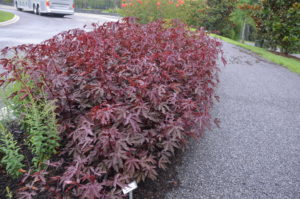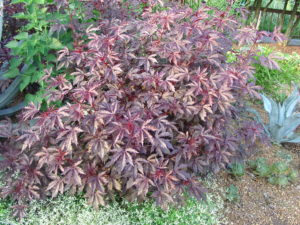African Rose Mallow (Hibiscus acetosella), aka Red-leaf Hibiscus and false Roselle, is grown in most of the U.S. as a colorful annual, although it is rated as a perennial shrub for USDA Zones 9-11. It is native to Africa and, as expected, thrives in hot tropical environment such as in the deep South or Southern California and Arizona where the growing season is a lot longer. Many U.S. gardeners grow rose mallow for their tropical foliage in summer and not for their flowers.
Rose mallow starts blooming in very late summer when daylength becomes shorter. Bloom continues through the winter until frost, or in tropical climates until daylength increases. Individual blooms measure 3.75 inches (9.5 cm.) and last one day.
If grown under full sun and adequate soil moisture, plants become deeply rooted and do not require staking. Foliage color is more intense and blooms fully in open sunny sites. Leaf hues are not as intense in partial sun and plants may need staking. They’re fast growing, up to 5 to 7 feet, along with a narrow single main stem. To promote a better branched, shrubbier habit, pinch off the apical growing tip several times during the summer to develop a stocky 3- to 6-foot tall plant.
Plant it in any well-drained garden soil or in a rapidly draining potting mix when grown in large containers. To repeat this tropical hibiscus flourishes in areas with high summer heat and humidity. Leaves also tolerate salty air along coastal areas.
‘Red Shield’, ‘Cranbury’, and ‘Maple Sugar’ are popular cultivars (possibly the same variety?). Their glossy purplish-red multi-lobed foliage looks similar to Japanese maples.
The brightly colored flowers attract numerous insect pollinators and birds and hummingbirds. Usually deer stay away. Leaves are edible, the crunch of leaf lettuce, but with a slightly bitter taste (in my opinion). Please pass the salad dressing.



 Posted in
Posted in 
